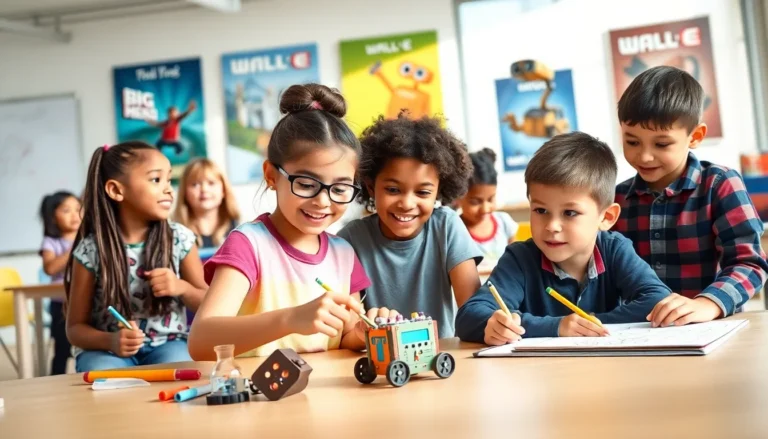Table of Contents
ToggleIn today’s digital age, video game design has emerged as an exciting avenue for kids to explore their creativity and technical skills. With the rise of interactive entertainment, children are not just players but potential creators, shaping the future of gaming. This shift empowers them to turn their ideas into engaging experiences, fostering problem-solving abilities and teamwork.
As young minds dive into the world of game design, they discover a blend of art, storytelling, and technology. Learning to create games can spark a lifelong passion for coding, design, and innovation. Whether through online courses or hands-on workshops, kids are finding ways to express themselves in this dynamic field, paving the way for future careers in the gaming industry.
Overview of Video Game Design for Kids
Video game design for kids encompasses multiple elements that foster creativity and learning. Kids engage in various aspects, including conceptualization, graphic design, coding, and testing. By exploring these components, children develop critical thinking and technical skills.
They participate in numerous platforms and tools designed for young learners. Programs like Scratch and Minecraft allow kids to create games easily. These platforms often provide tutorials and community support, encouraging collaboration among peers.
Workshops and online courses offer structured learning experiences. Many organizations focus on helping kids grasp the fundamentals of game design and programming languages. These educational paths often lead to increased confidence and self-expression.
Projects that incorporate storytelling bring narrative depth to games. Children learn to craft compelling storylines and characters, enhancing their creative writing skills. Successful game design often merges artistic and technical elements, creating a holistic learning environment.
As kids pursue video game design, they familiarize themselves with industry standards. Learning about user interface design and game mechanics exposes them to professional practices. Such experiences prepare them for future academic and career opportunities in the gaming field.
Benefits of Learning Video Game Design

Learning video game design offers numerous advantages that support children’s growth in various areas. Engaging with game development fosters essential skills that benefit them academically and socially.
Cognitive Development
Learning video game design significantly enhances cognitive abilities. Kids develop critical thinking skills by solving complex problems during the design process. They learn to analyze game mechanics and make strategic decisions that affect gameplay outcomes. Multitasking skills improve as they balance coding, artistic creation, and storytelling, while also managing deadlines for project completion. Furthermore, programming languages like Scratch encourage logical reasoning, as children write and debug code, reinforcing their understanding of cause and effect.
Social Skills Enhancement
Video game design cultivates social skills through collaboration and teamwork. Kids often work in groups to create games, necessitating communication and sharing of ideas. They practice negotiation skills when discussing design choices and managing differing opinions. Collaborative projects encourage empathy, as young designers learn to appreciate diverse perspectives, ultimately fostering a sense of community. Participating in workshops and online forums further strengthens these social connections, allowing children to develop networking skills crucial for their future careers in the gaming industry.
Tools and Resources for Young Designers
Children interested in video game design can access various tools and resources to enhance their skills. The following categories provide specific options tailored for young designers.
Software Options
- Scratch: A free, visual programming platform that allows kids to create games through block-based coding. Scratch encourages creativity and experimentation in game design.
- Roblox Studio: A user-friendly game development environment that enables kids to design and publish their games. Roblox Studio provides extensive resources like tutorials and community support.
- Unity: A powerful game engine suitable for older kids and teens. Unity offers extensive documentation and a range of online tutorials, making it accessible for beginners.
- GameMaker Studio 2: This platform simplifies game creation with a drag-and-drop interface, suitable for beginners. GameMaker also supports coding, allowing for advanced design as skills improve.
- Tynker: This platform includes coding lessons tailored for children, integrating game design into its curriculum while offering a fun, interactive interface.
Online Courses and Workshops
- Kano: Kano provides hands-on workshops and online courses focused on game design. Their resources empower kids to learn coding while creating their games.
- Code.org: This platform offers various coding courses, including game design. Kids can learn at their own pace through engaging lessons and interactive projects.
- Coursera: Several universities offer courses on game design that cater to young learners. These structured programs often include video lectures, projects, and peer interaction.
- iD Tech: iD Tech offers summer camps and online courses focusing on game design and coding. These programs provide hands-on experience with popular game engines.
- Community centers and libraries: Local organizations frequently host workshops that focus on game design for kids, providing a collaborative environment to learn and create together.
Popular Game Design Concepts for Kids
Understanding popular game design concepts equips kids with essential skills and knowledge for creating engaging games. Two vital aspects of game design are game mechanics and storytelling.
Game Mechanics
Game mechanics form the backbone of gameplay. They define how players interact with a game and influence the overall experience. Key components of game mechanics include:
- Rules: Establish the framework within which players operate.
- Objectives: Provide clear goals for players to achieve, driving engagement.
- Challenges: Present obstacles that players must overcome, enhancing difficulty and excitement.
- Feedback Systems: Offer responses to player actions, helping them understand their progress and the consequences of their choices.
By exploring these components, kids learn to create interactive experiences that keep players invested.
Storytelling and Narrative
Effective storytelling in video games fosters emotional connections between players and the game world. Essential elements of storytelling and narrative include:
- Characters: Create relatable and dynamic characters that resonate with players.
- Plot: Develop a compelling storyline to guide players through challenges and discoveries, maintaining interest.
- World-building: Construct immersive environments that enrich the game experience and enhance the narrative.
- Conflict: Introduce tension or struggles that characters face, allowing players to engage with the story on a deeper level.
Incorporating strong storytelling elements helps children appreciate the art of narrative while enhancing their creative writing skills in game design.
Embracing video game design opens a world of possibilities for children. It nurtures creativity while building essential skills like problem-solving and teamwork. As kids learn to navigate the complexities of game creation they not only gain technical knowledge but also foster a love for storytelling and innovation.
With numerous resources available from online courses to community workshops young designers can thrive in a supportive environment. This growing interest in game design prepares them for future careers in the gaming industry while enriching their educational experiences. Encouraging kids to explore this dynamic field can lead to exciting opportunities and a lifelong passion for creativity and technology.







